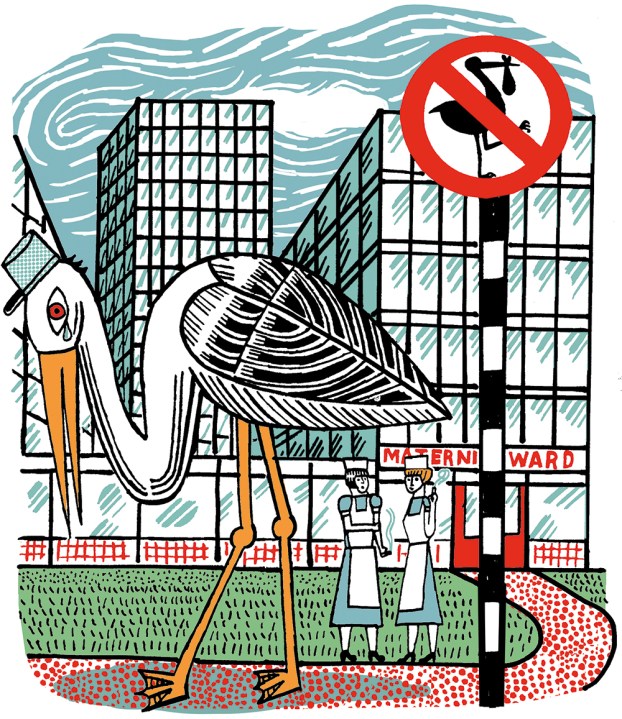
It was a routine antenatal appointment. I’d done it twice before and knew the format. The obstetrician runs through the risks of an elective caesarean (ELCS). We agree a date, I sign the forms, then make a plea for adequate pain relief after the surgery, which I know will be ignored.
So I was blindsided by her opening gambit. ‘Why don’t we tie your tubes when we’ve got the baby out?’ she said, or something similar – I don’t recall the exact words, but I do remember the heat in my chest, the confusion and fear.
‘What?’
‘It’s your third child, isn’t it, so why don’t we tie your tubes at the same time?’
She wouldn’t drop it, ignoring my every assertion that I did not want this done to me. ‘It’s a very simple procedure when you’re open on the table,’ she said silkily. (I’ve since learnt that it isn’t.) I lost it after that, so she changed tack, offering to ‘pop in a Mirena coil at the same time’.
Again, a hard ‘no’ from me. At that stage I still thought we might have a fourth child. I was outraged at this unsolicited comment on the size of our family. I left in a terrible state, stressed and upset that they wanted to do this to me.
Then, shortly before I had my daughter, I met up with my friend Tess, who was booked in for an elective caesarian at a neighbouring NHS trust in London, due to placenta previa. We chatted about what it involved; her two older children had been natural births. ‘Can you believe,’ said Tess, ‘the first thing the consultant said to me was, “Now I understand this is your third child. Why don’t we tie your tubes at the same time?”’
Like me, Tess wasn’t sure she was finished having babies. This ‘offer’ of sterilisation wasn’t because of any concern about mine or the baby’s health, she said ‘It was just his assumption that I wouldn’t want any more children after three’. I had a straightforward third pregnancy, but when my daughter was born in October 2019, she was unresponsive at first. By the time I came round from the anaesthetic she’d been whipped upstairs to neonatal intensive care, convulsed by seizures. No one could tell us if she would live; our priest came to baptise her on the second day.
I remember thinking that if my daughter died, the only way I could possibly navigate the grief would be by getting pregnant again as quickly as possible. Discharged without her, I had quite a bit of time to dwell on the fact that, if I had consented to sterilisation, one doctor would have been permanently removing my ability to bear more children while my baby was being resuscitated.
We eventually brought Romy home after a month, with a diagnosis of cerebral palsy and prognoses ranging from poor to dire. There were so many things to sort out – feeding, mobility, a speech delay, her crucial therapy cancelled in lockdown – that I never raised the sterilisation issue with the trust. But it was there in my peripheral vision.
I remember thinking that if my baby died, the only way to navigate the grief would be to get pregnant again
It’s only recently, with Romy confounding the experts to join her brothers at a mainstream primary school, that I’ve had the headspace to investigate what happened.
I posted on social media about what the obstetrician had said. Within a few days I had seven case studies with a good geographical spread, ages ranging from 36 to 42, dating from 2005 to so recently that the baby still hasn’t been born. Three of the women were in their mid-thirties when they were urged to undergo sterilisation. For two women, it was only their second child.
All the women I spoke to had been traumatised by these unsolicited offers and confused about why they had been targeted. Most felt it was a judgment on the number of children they ‘should’ have. All of them were surprised to learn that it hadn’t just happened to them.
Liberty, 37, who is expecting her third child imminently, came away from an antenatal appointment unaware that the doctor (‘whose English was dreadful’) had written in her notes that she’d agreed to sterilisation. Her midwife flagged it two days later and it was taken off her notes.
Only one woman had been given a medical reason. Elizabeth, a scientist, had had two emergency sections and was offered an elective with her third child. The medical professionals told her she was high risk, so ‘for ease, we can tie your tubes while you’re still open’. ‘There was a valid point in my case but I felt dehumanised,’ she says. ‘She almost had me, but I went away and the more I thought about it, the more horrified I was. I question now whether it would even have been informed consent.’
One woman was last year offered sterilisation with ELCS for her third child at the age of 37, by NHS Lothian in Edinburgh. ‘It was just dropped into the conversation,’ she told me. ‘I made my own assumptions and have been wondering whether to raise it with the trust ever since.’ She is black and, until we spoke and I mentioned sterilisation being offered to mothers with two or more children, she assumed that this may have been a factor in why sterilisation was offered to her.
Something has gone hideously wrong when women assume that NHS doctors want to sterilise them because of, variously, the colour of their skin, their age or simply the size of their family.
Who is to blame? The trust where I had my babies apologised ‘if this caused any surprise or distress’, saying: ‘We can confirm that we do not have a policy that states staff should offer sterilisation with ELCS to women having a third child.’
I try the National Institute for Health and Care Excellence, which advises the NHS. It doesn’t have a policy on sterilisation and directs me to the Royal College of Obstetricians and Gynaecologists. It declines to comment and suggests I contact the Faculty of Sexual and Reproductive Healthcare, which advises women on contraception.
Its president, Dr Janet Barter, listens to my findings and exclaims: ‘I feel I should apologise on behalf of the medical profession. [It] judges women.’ Dr Barter explains: ‘When I was in obstetrics 30 years ago, it was quite standard to almost tell women they needed to be sterilised after their third c–section – but surgery has improved enormously since then.’
I point out that safety concerns were only raised with one of the women, and in most cases the doctor had simply assumed they wouldn’t have any more children – or thought that they shouldn’t.
‘That sounds shocking,’ she agrees, ‘because it is the woman’s right to choose how many children she has. We encourage obstetricians and midwives to think with women about what contraception they want to use after the baby’ – but this should take the form of ‘an utterly non-judgmental conversation with you at some safe point in your pregnancy’. Dr Barter says sterilisation is a highly emotive subject because historically it is something that has been done to women against their will – to the Roma by the Nazis or to Native Americans in the 1960s and 1970s.
Dr Barter also points out that sterilisation, or tubal ligation, is less successful and less safe when done at the same time as a caesarean. The procedure is different because the tubes are swollen due to the pregnancy, so they are cut rather than tied. However the procedure can reverse in around one to two cases per 100 women. When this happens the chances of an ectopic pregnancy are much higher. About 60 per cent of women who do go on to conceive after a failed sterilisation will suffer an ectopic pregnancy. Further, ‘we know that the level of regret is more when sterilisation is done at the same time as a section’. Dr Barter says she would like to see women treated as ‘dare I say it, people. It’s our job to talk to women about risk and benefits, not about what they should do’. She tells me I need to go back to the Royal College.
‘Some women in some cultures are very afraid to say to their husbands that they want contraception’
No clearer about where this policy is coming from, I ask to talk to the Royal College’s president, Dr Ranee Thakar. Then, while I’m waiting for a response, I have a brainwave. Because of my daughter’s nightmarish start to life, I had to go in for a debrief with my obstetrician – the one who’d offered to sterilise me. Her number is still saved in my phone.
I call her, saying I’m letting everyone who was involved in Romy’s early care know that she is now thriving in a mainstream primary (which is true) but that I need closure about something that happened before she was born. She remembers Romy and agrees to answer my questions.
‘It’s not a policy, it’s just a discussion,’ she insists. I point out how shocked I was, and she concedes that ‘some women don’t respond well’. ‘It’s first of all so people can have a choice of contraception at delivery… Some women in some cultures are very afraid to say to their husbands that they want contraception.’
But I’m very obviously not from one of those cultures, I say. Why don’t you treat women as individuals? ‘The NHS doesn’t cater for that,’ she replies. ‘And the other thing is, after the third caesarean, it does get very tricky.’ (There is no medical agreement on how many c-sections are ‘safe’.)
As to the impetus for sterilisation, she says: ‘I’m sure I’ve read it in [Royal] College guidance… it’s partly passed down, partly what we’ve learnt from our predecessors. [But] we’re a different generation and we do fewer sterilisations now because we’re introducing a lot of long-term reversible contraception.’
Armed with this, I go back again to the Royal College which, after a lot more badgering, directs me to ‘guidance’ that recommends as part of the ‘counselling’ for women having repeat electives that they should be offered the ‘option for sterilisation if fertility is no longer desired’. Not one of the women I had spoken to had expressed any ‘desire’ to have their fertility excised, I reply, but this is the end of the conversation.
With the birth rate in England and Wales at a historic low, I’d argue that women should be supported to have three, four, even five babies – however many they choose – and that it shouldn’t matter which way they are delivered. What they should not be confronted with during pregnancy is a question about whether they want to terminate their fertility.








Comments